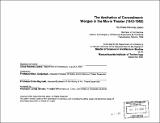The aesthetics of concealment : Weegee in the movie theater (1943-1950)
Author(s)
Ramirez Jasso, Diana, 1973-
DownloadFull printable version (11.65Mb)
Other Contributors
Massachusetts Institute of Technology. Dept. of Architecture.
Advisor
Mark Zarombek and Erika Naginski.
Terms of use
Metadata
Show full item recordAbstract
Between 1941 and 1945, movie theaters in the United States enjoyed a period of intense activity marked by record levels of attendance. Film scholars have explained this phenomenon by referring to the fascination exerted by "escapist" Hollywood films, which either idealized or completely negated the harsh economic and social conditions brought about by the outbreak of World War II. However, American photographer Arthur Fellig "Weegee" produced between 1943 and 1950 a series of photographs that reveal a more complex reality of movie going. Using infrared film and an invisible flash to cut through the almost complete darkness of the theater, his pictures reveal a peculiar function of the movie house at a specific moment in the history of the United States. By analyzing these photographs in the context of other sources of information such as posters, newspapers and magazine articles of the time, the dark and permissive interior of the movie theater emerges as an effective refuge from the violent forms of visual interaction that were established in public space as a consequence of wartime threats over American territory. Thus, at the time they serve as a starting point to recover a forgotten moment in the urban history of the United States, the images prompt a reevaluation of the spatial conditions of the movie theater itself-a site for public interaction that, interestingly, fosters unique forms of privacy and intimate exchange.
Description
Thesis (S.M.)--Massachusetts Institute of Technology, Dept. of Architecture, 2002. "September 2002. Includes bibliographical references (p. 175-189).
Date issued
2002Department
Massachusetts Institute of Technology. Department of ArchitecturePublisher
Massachusetts Institute of Technology
Keywords
Architecture.